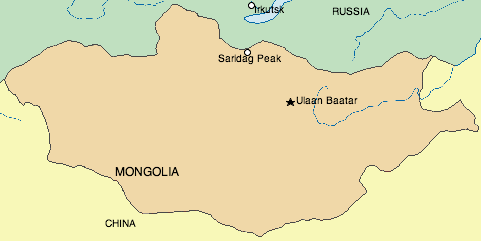Message from Ulaan Bataar
Saturday, October 9th, 2004
Greetings-
Have been in Mongolia for the past week–initial few days in a ger bordering on a national park–lazy, relaxing days with hiking and Mongolian pony riding (when on the horse my feet nearly reach the ground). Then had only 2 days for Ulaan Bataar, the capital. Weather was so pleasant and culture such a change of pace following Russia that we decided to stay longer. However train only passes through town once a week, more time here than what we need but that’s ok.
First couple of days we did the home-stay thing but the hostess spoke no English and was a bit shy to interact so moved to a hotel. Lodging too expensive but all else cheaper–can take a taxi from one end of town to the other for less than a buck.
Yesterday went to a huge local market. Guidebooks said to take care re thievery (advice in the realm of one’s mother saying to wear a coat). But while there my packback received a gash and a similar long slash across my pant leg in the general area where someone saw me depositing change. I was aware of the contacts so nothing lost but do have a superficial cut on my thigh. That sort of action leaves an uncomfortable feeling. I was told that the local Mongolians are equally at risk but for some reason I stick out in a crowd (boyish good looks perhaps).
This city (Ulaan Bataar) has a bit of a cowboy feel–most roads not paved and well pot-holed, horse carts compete for space with autos who obey some sense of order only peripherally, older folks still wear their long brightly colored coats (deels) with and an orange sash, everyone under 40 in jeans, black leather jackets and constantly fiddling with their cell phones (same-same at all latitudes and longitudes). Tiz too bad as all interesting ethnic features/diversities will soon be lost–well on our way to a homogenized worldwide culture.
The Mongolians have features that are different than other Asians. They seem to universally dislike the Chinese but respond favorably when asked about Russians–surprising as the country was part of the Soviet Union until 1990. All that I have talked to however are much happier with independence. Too many soviet style buildings remain in the city and many of the people within the city still live in gers (50% by one guide book estimate).
Our next move is to Beijing; then no agenda. Probably will work our way down the east coast of China to Shanghai, then either inland or to Hainan Island in So. China Sea off the coast of Vietnam. Our fixed and booked trans-siberian itinerary ends in Beijing so then the fun begins with winging it again, buying train tickets in Mandarin, etc.-Chinese characters even harder for these poor foreigners than Cyrillic. Many Chinese find it difficult to believe that someone does not speak their language. And therein is the adventure.
Hope all are well. Please send money.
RLG

